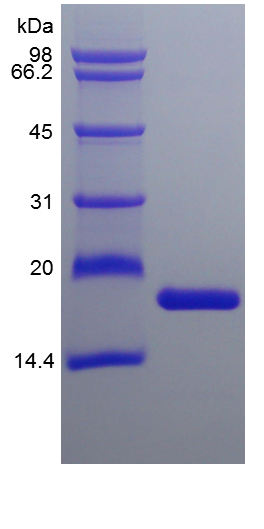- Synonyms
- FIL1 epsilon, IL-1 epsilon, IL-1F6, IL-1H1
- Source
- Escherichia coli.
- Molecular Weight
- Approximately 18.0 kDa, a single non-glycosylated polypeptide chain containing 160 amino acids.
- AA Sequence
- MNKEKELRAA SPSLRHVQDL SSRVWILQNN ILTAVPRKEQ TVPVTITLLP CQYLDTLETN RGDPTYMGVQ RPMSCLFCTK DGEQPVLQLG EGNIMEMYNK KEPVKASLFY HKKSGTTSTF ESAAFPGWFI AVCSKGSCPL ILTQELGEIF ITDFEMIVVH
- Purity
- > 95 % by SDS-PAGE and HPLC analyses.
- Biological Activity
- Fully biologically active when compared to standard. The specific activity determined by its ability in a functional ELISA. Immobilized rMuIL-36α at 1 µg/mL can bind recombinant murine IL-1 Rrp2 with a range of 0.15-5 µg/mL.
- Physical Appearance
- Sterile Filtered White lyophilized (freeze-dried) powder.
- Formulation
- Lyophilized from a 0.2 μm filtered concentrated solution in PBS, pH 7.4, 5 % trehalose.
- Endotoxin
- Less than 1 EU/μg of rMuIL-36α, 160a.a. as determined by LAL method.
- Reconstitution
- We recommend that this vial be briefly centrifuged prior to opening to bring the contents to the bottom. Reconstitute in sterile distilled water or aqueous buffer containing 0.1 % BSA to a concentration of 0.1-1.0 mg/mL. Stock solutions should be apportioned into working aliquots and stored at ≤ -20 °C. Further dilutions should be made in appropriate buffered solutions.
- Stability & Storage
- Use a manual defrost freezer and avoid repeated freeze-thaw cycles.
- 12 months from date of receipt, -20 to -70 °C as supplied.
- 1 month, 2 to 8 °C under sterile conditions after reconstitution.
- 3 months, -20 to -70 °C under sterile conditions after reconstitution.
- Usage
- This material is offered by Shanghai PrimeGene Bio-Tech for research, laboratory or further evaluation purposes. NOT FOR HUMAN USE.
- SDS-PAGE

- Reference
- 1. Nicklin MJ, Barton JL, Nguyen M, et al. 2002. Genomics. 79:718-25.
2. Dinarello C, Arend W, Sims J, et al. 2010. Nat Immunol. 11:973.
3. Barksby HE, Lea SR, Preshaw PM, et al. 2007. Clin Exp Immunol. 149:217-25.
4. Smith DE, Renshaw BR, Ketchem RR, et al. 2000. J Biol Chem. 275:1169-75.
5. Dunn E, Sims JE, Nicklin MJ, et al. 2001. Trends Immunol. 22:533-6.
- Background
- Interleukin-36 (IL-36) is a pro-inflammatory cytokine which plays an important role in the pathophysiology of several diseases. IL-36α, IL-36β, and IL-36γ (formerly IL-1F6, IL-1F8, and IL-1F9) are IL-1 family members that signal through the IL-1 receptor family members IL-1Rrp2 (IL-1RL2) and IL-1RAcP. IL-36α is mainly found in skin and lymphoid tissues, but also in fetal brain, trachea, stomach and intestine. It is expressed by monocytes, B and T cells. Notably, IL-36 alpha is the only novel IL-1 family member expressed on T-cells. Recombinant murine interleukin-36 alpha contains 160 amino acids residues which is a single non-glycosylated polypeptide. Specifically, mouse IL-36α shares 83 % a.a. sequence identity with rat IL-36α, 54-60 % with human, rabbit, equine and bovine IL-36α.

 COA申请
COA申请
